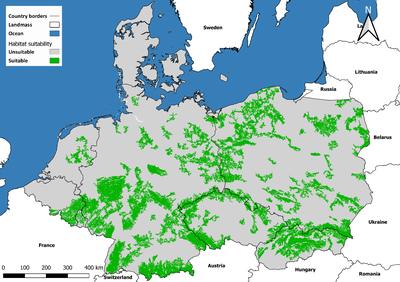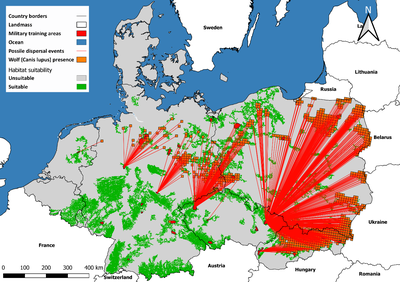Assessing the potentially suitable habitat for the grey wolf (Canis lupus) in Central Europe
Leon Eichfuss
The grey wolf (Canis lupus) was once the most widespread large carnivore species of the Northern Hemisphere. However, the historical distribution of the species has declined as a result of intense trapping and hunting from at least the sixteenth century onwards. Over the last decades however, several factors created a positive ecological and legislative environment for an almost continental wide recovery of the species in Europe. The population and range size of the wolf in Europe is generally increasing, particularly in Central and Western Europe. This, however, comes with a high potential for an increased human-wolf conflict. The aim of this study is to model the extent and distribution of potentially suitable wolf habitat in present Central Europe using MaxEnt, an empirical habitat distribution model, to estimate the number of potentially suitable wolf territories in Central Europe and assess which regions of Central Europe are most likely to be recolonized next by the grey wolf, using a nearest neighbor analysis. This research also takes the key roles of military training areas and nature protection areas, regarding the recovery of the wolf in Europe, into account. My results show that almost all regions of the study area contain potentially suitable habitat for the wolf. 61 % of this suitable habitat is large enough to represent approximately 1100 potentially suitable wolf territories within the study area. These are most prominent in low mountain ranges in Slovakia, Germany, the Czech Republic, and southern Poland. Thus, these are the regions that are most likely to be recolonized next by the wolf, given their relatively close location to already existing wolf territories. It is important to anticipate and prepare for a return of the wolf, especially in these regions to be able to anticipate and plan for future human-wildlife conflict.

|
Fig. 1: Map of areas that represent potentially suitable wolf territories. |

Fig. 2: Map showing which areas of Central Europe will probably be recolonized next by the wolf.

